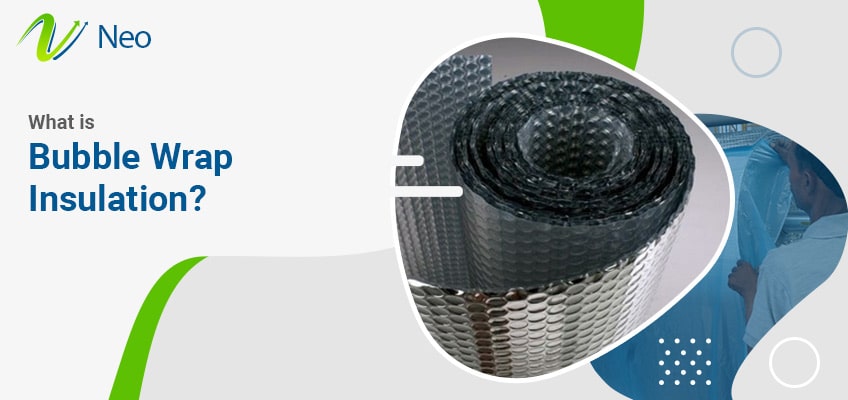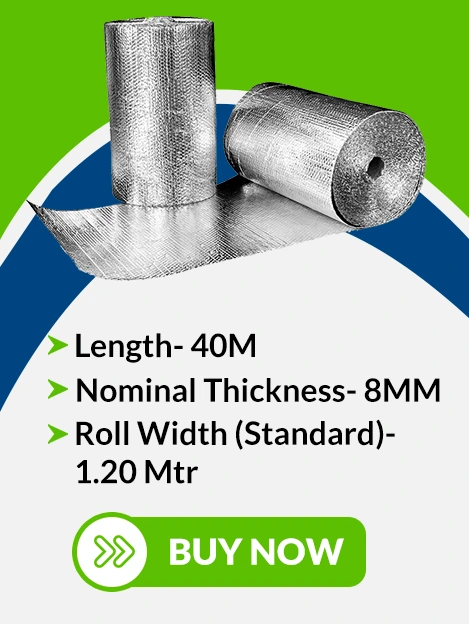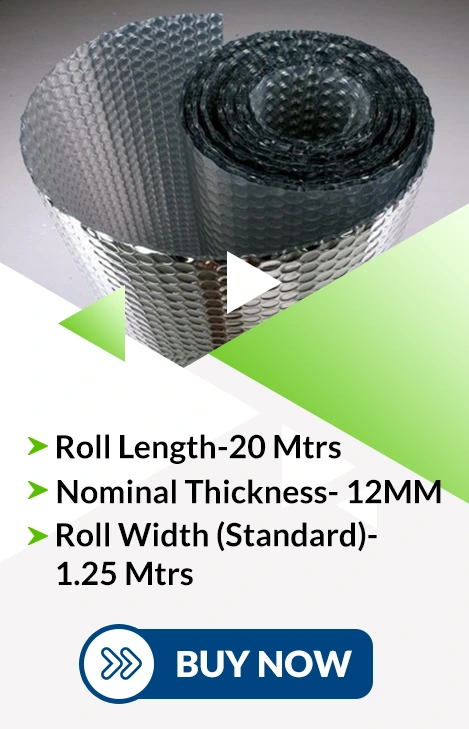Bubble Wrap Insulation(Benefits & Types)

Just like many other discoveries, an accident led to the discovery of bubble wrap insulation. When two engineers were sealing the two plastic curtains together, air got trapped between them, leading to the innovation named bubble wrap.
Bubble insulation is now one of the most effective ways to insulate residential and commercial buildings with low cost and high reliability. This material offers sustainable as well as environment-friendly solutions to those who are looking for affordable insulation.
In this article, we will cover every aspect related to bubble wrap. You will get to know, what is air bubble insulation, how it is made, the benefits of using it, the different types of bubble insulation, and how to install the insulation.
What is Bubble Wrap Insulation?
Air bubble insulation is a sustainable and environment-friendly solution for modern thermal insulation requirements. The insulation material is an amalgamation of reflective surfaces with and air bubbles present between the reflective layers. The air bubble acts as a thermal barrier that traps heat and prevents heat transfer through conduction and convention between an object and the surroundings. The air bubbles sandwiched between the layers create small air pockets that act as an insulator for thermal insulation.
Bubble wrap can be used both in summers and winters as it diminishes heat loss during winters and heat gain in summers. The r value of bubble wrap insulation lies between R-3 and R-5 per inch, depending upon the thickness and composition of the material used in the process. In addition to this, it is lightweight, flexible, malleable, inexpensive, and easy to install, making it a perfect fit for duct pipes, roofs, ceilings, walls, pole barns, crawl spaces, metal buildings, ware houses, and freezers.
What makes bubble insulation a popular choice is its ability to offer energy-efficient solutions. It is efficient in controlling indoor temperature. It is convenient for use in commercial and residential spaces.
Bubble Insulation: How is it Made?
Air bubble insulation , commonly known as bubble wrap foil insulation, is made up of different types of insulation materials, like low-density polyethylene. In the process, plastic films are combined with the layers of air bubbles to create air pockets for thermal resistance.
Here are the steps to follow to make this insulation material:
- Plastic films and air are the main components of bubble wrap insulation. A durable and flexible polymer (polyethylene) is used to manufacture plastic films.
- Temperature has a very important role in the manufacturing process of bubble insulation. The process begins with the melting of polyethylene at a high temperature (around 450 degrees Celsius) to form a thin plastic film. The thickness of this film depends on the required insulation properties.
- After the conversion of polyethylene pellets into plastic films, these films are passed through several rollers with small and heated pins. The pins are used to create small-size hemispherical holes for air bubbles to trap air within them. The whole process is done with the help of pressure applied on the plastic film.
- After creating air bubbles in the plastic film with the help of pressure, the next step is to apply another layer of plastic film to add durability and flexibility. Thus sealing and creating air tight pockets of air. It increases the insulation properties of the material and curtails heat transfer.
- To curtail material from expanding unnecessarily, the perforation process is done. Under this, extra air is removed from the material.
- For enhancing performance and durability, when required, certain additives like flame retardants, UV stabilizers, reflective coatings, etc. are added to the insulation material.
In the last, the bubble insulation material is cut down into sheets of different sizes and rolled to make them suitable for transportation.
Benefits of Using Bubble Wrap Insulation
There are various types of benefits to using foil bubble wrap insulation. It is a perfect fit for homeowners, commercial, and industrial establishments’ energy requirements:
- Efficient Energy Usage: Bubble thermal insulation curtails heat loss and heat gain during the summer and winter climates, respectively, and helps in maintaining the desired indoor temperature. It helps energy appliances run efficiently and resist any unwarranted energy load on them without any extra cost. It leads to efficient energy use and lower bills.
- Cut-Down Cost: In comparison to other insulating materials, bubble wrap insulation is not only less expensive but also requires a minimum cost for installation. It is one of the best options for those who have a restrained budget and are looking for reliable and thermally efficient insulation options.
- Easy to Install: The material used in the manufacturing process of bubble wrap made it lightweight, flexible, durable, and easy to install. If one opts for the right installation technique and has all the required tools, one can easily install it. It can be cut into different sizes as needed without any difficulty. It is a perfect material for insulating wall insulation, ceilings, floors, crawl spaces, attics, and underfloor insulation.
- Resist Moisture: Bubble wrap insulation is anti-humid and increases the lifespan of building materials by preventing the accumulation of moisture inside and outside the insulated material. It also creates a barrier for condensation in cold climates, thus providing 360-degree protection.
- Durable: The insulation material is resistant to wear and tear and offers long-lasting durability. It means that once applied, it will insulate materials for the long term.
- Versatile: This is a versatile material and can be used for different purposes. It can also easily roll down into sheets of various sizes due to its flexibility. It is compatible with both residential and commercial building requirements.
- Soundproof: It is a soundproof material. It is used to absorb and restrict sound transmission between the surface and the surroundings.
- Environment-Friendly: Recycled material is used in the manufacturing of bubble wrap insulation to protect the environment. It restricts the use of hazardous materials and offers environment-friendly insulation options.
Make Your Home More Energy-Efficient With Bubble Wrap Insulation
Types of Air Bubble Insulation
Single Bubble Wrap Insulation
Single bubble insulation is one of the most common insulations used for thermal efficiency. As its name suggests, the material consists of only one reflective surface with bubbles of about 3/8 inch in diameter. It creates small air pockets to reduce heat transfer between the surface and the surroundings. It is efficient when moderate insulation is required without any specific requirements. The single air bubble insulation is resistant to moisture and versatile in use.
Applications:
- Use where moderate insulation is required.
- Use in crawl spaces, handles, and doors of garages.
- Use as packaging material and as a protective covering for fragile items.
Advantages:
- It is both cost-effective and affordable.
- It is easy to install.
- It offers resistance against moisture and UV radiation.
- It is lightweight, durable, and flexible.
Double Bubble Wrap Insulation
Double bubble wrap insulation is a combination of two insulating layers of bubble wrap and reflective foil (commonly aluminum) that acts as a separating material between two bubble wrap layers. In this material, multiple air pockets are created between the layers, which increases thermal efficiency for better insulation. Double bubble wrap insulation is more effective than single bubble wrap.
Applications:
- Use for walls, attics, and crawl spaces.
- Use for underfloor insulation.
- Use for ductwork and pipes
- Use for greenhouses.
- Use for shipping and packaging.
Advantages:
- It enhances the thermal performance of the material several times.
- It offers effective resistance against moisture and condensation.
- It is easy to install and versatile.
- It is lightweight, durable, and flexible.
Reflective Bubble Insulation
Bubble wrap reflective insulation is an amalgamation of bubble wrap and metallic foil to reduce radiant heat transfer. It consists of aluminum foil combined with layers of bubble wrap to enhance thermal efficiency and lower utility costs. It prevents heat transfer through conduction and convection between the insulated surface and the surroundings. Inside bubble wrap reflective insulation, bubble wrap layers are sandwiched between the metallic foil that curtails heat from penetrating interiors. These layers induce small air pockets that reduce heat transfer.
Applications:
- Use for insulating roofs and attics.
- Use in metal buildings where temperature fluctuation and condensation are important issues.
- Use in radiant floor heating.
- Use in transportation, such as transport trucks and cold-storage trucks.
- Use in cold storage facilities.
Advantages:
- It has a high thermal-resistance material.
- It is lightweight, flexible, and durable
- It is versatile and offers resistance against moisture and condensation.
- It is easy to install.
Bubble Wrap with Foam
Bubble wrap with foam is a combination of bubble wrap and foam material like expanded polystyrene (EPS) or polyethylene. The extra layer of foam in the insulation material offers supplementary thermal efficiency and curtails heat transfer through conduction and convection. The material present in bubble wrap with foam insulation adds additional R-value and improves overall insulation efficiency. The foam material helps bubble wrap layers to create small air pockets that act as an insulator.
Applications:
- Use to insulate walls and attics.
- Use for underfloor insulation.
- Use in packaging and shipping.
- Use in providing cushioning and protection to fragile items.
- Use in making thermal blankets.
Advantages:
- It has good thermal performance.
- It can act as a soundproofing material.
- It is easy to install and versatile.
- It is flexible, durable, and moisture-resistant.
Bubble Wrap with Woven or Non-Woven Fabric
Bubble wrap with woven or non-woven fabric is an effective insulating material. The material is prepared by placing layers of bubble wrap material between the layers of woven and non-woven fabric, determining enhanced insulation ability and improved thermal resistance. The woven fabric is obtained from yarns and threads, while the non-woven fabric is made of artificial fibers. The woven or non-woven fabric in bubble wrap with woven or non-woven fabric insulation provides strength, flexibility, and durability to the material. It protects bubble wrap layers from any additional damage during installation.
Applications:
- Use for exterior walls.
- Use in metal buildings.
- Use in shipping and packaging.
- Use to insulate outdoor sheds.
- Use to create thermal covers for outdoor furniture.
- Use to make a protective layer for gardening tools.
Advantages:
- It increases the durability and flexibility of a material.
- It improves the tear resistance of a material.
- It is a good soundproofing material.
- It provides extra protection against dust particles.
- It is a versatile material and easy to install.
Different Ways to Use Air Bubble Insulation?
Bubble wrap insulation is one of the best insulating materials for enhanced energy efficiency and thermal insulation requirements in residential, commercial, and industrial buildings.
Here are a variety of places where bubble wrap used as insulation:
- Walls: Walls are the parts of a building from where maximum heat gain and heat loss take place; hence, it is necessary to insulate walls for economical energy bills; bubble wrap on walls and between wall studs helps reducing transfer of heat and maintains a desirable indoor temperature without excessive utility costs.
- Attics: Insulating attics with bubble insulation is a better option than insulating them with traditional insulating materials. Attics are places where a large amount of heat escapes to the surroundings, resulting in energy loss. In winter, bubble wrap is used as insulation for insulating attic floors and between rafters.
- Windows: Windows bubble wrap insulation is not only necessary but also desirable for your house’s thermal insulation efficiency. The windows are necessary for warmth and light; however, a large amount of heat escapes from them, ensuring energy loss. Window bubble wrap prevents heat loss and gain by creating small thermal buffer zones when used from inside; it enhances the energy efficiency of a building.
- Crawl Space: Creating a thermal barrier between crawl spaces and their surroundings is necessary. Providing bubble wrap insulation around floor joists and between the ground and the space above prevents heat transfer of heat and increases overall insulation.
- Pipes: Bubble wrap for pipe insulation is used to minimize the incidence of water freezing during cold climates. The bubble wrap protects pipes from unnecessary wear and tear and provides a long life.
- Greenhouse: Bubble wrap insulation can be used to insulate the interior walls of greenhouses. It helps to trap the sun’s energy and maintain an optimal temperature for plant growth. The insulation provides additional benefits for better plant growth.
- Packaging: Bubble wrap used as insulation to provide protection to fragile items like glass materials, electric appliances, and other precious items during shipping and storage. Bubble wrap has excellent cushioning properties and saves products from damage and loss.
- Other Uses: You can employ bubble wrap in a variety of different places, like water tanks, dog- houses, water-heaters, and various DIY projects for insulation. It has majestic properties that make it suitable for unconventional uses.
The above mentioned cases show how bubble wrap used as insulation for better insulation, thermal efficiency, and comfort in daily life.
Upgrade Your Home Cozy and Save Energy With Bubble Wrap Insulation!
How to Install Bubble Insulation in Your Buildings
Bubble wrap installation in residential or commercial buildings will ameliorate overall thermal efficiency and result in improved energy savings.
Here is a guide on how to install it.
- It is necessary to inspect and clean the surface before applying bubble wrap insulation. If any kind of debris, dust particles, or any other substance is present on the surface, it will hamper the proficiency of the insulating material, thus leading to improper results.
- Before applying insulation, gather the required tools for proper fitting. Materials like tape, scissors, a utility knife, adhesive spay, and other essential tools must be kept ready.
- Take the proper measurement of the area where insulation is going to be installed, like windows, attics, crawl spaces, or any other place. Cut the bubble wrap to the proper size and measurement. Make sure that the insulating material covers the surface properly for effective results.
- Be careful while placing bubble wrap insulating material on the surface of the object. Ensure that the insulation “droops” between points of attachment, and there must be 1 inch of air space between the insulated surface and the wrap.
After installing insulation, check for any uncovered gaps or any other fault. This may be the case when insulation is not done properly. Carefully find out the faults or gaps and seal them to ensure the best outcome.
Conclusion
Installing bubble wrap insulation will result in lower utility costs, consistent thermal efficiency, the desired indoor temperature, and comfort. In this article, we discussed important aspects of bubble wrap and made you aware of its benefits and versatile usage.
Bubble insulation is a profitable solution for those who are looking for an affordable and sustainable thermal insulation solution. It is an efficient solution for residential, commercial, or industrial buildings. It not only results in the better thermal performance of a building but also reduces energy bills. Bubble wrap insulation offers long-term and environment-friendly benefits for thermal insulation needs.
Frequently Asked Questions
1. What type of material is bubble wrap insulation?
It is made up of plastic films such as polyethylene. There are also special type of bubble wrap insulation material which consists materials like aluminum foil, foam (made up of expanded polystyrene (EPS) or polyethylene), woven or non-woven fabric.
2. What is the R-value of bubble wrap?
The R-value of bubble wrap insulation depends upon various factors like thickness, material contents, and number of layers. For example, the R-value of 3/8 inch bubble wrap is close to 1.3; on the other hand, the R-value of 3/8 inch bubble wrap foam is 1.6. It is important to note that the higher the R-value, the higher the thermal resistance.
3. How thick is bubble wrap insulation?
It comes in different kinds of thicknesses. The thickness of the standard size insulation varies from 3/16 inch to 5/16 inch. However, there may be more variation in thickness than the standards mentioned, depending on the material used.
4. Is bubble wrap insulation good for windows?
Window bubble wrap insulation is very effective and offers great help in achieving thermal insulation efficiency. The bubble wrap, when put on windows, traps air in small pockets and curtails heat transfer between the window and the surroundings. In addition to this, the insulation is not only easy to install but also easy to remove when needed.








